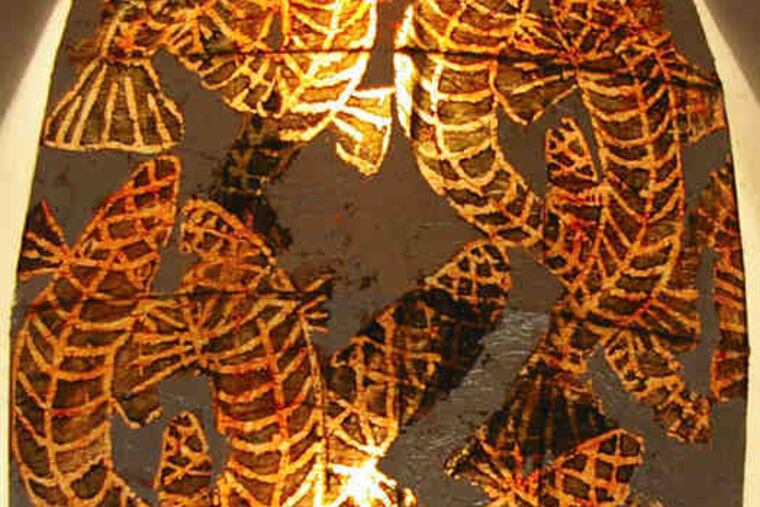
Two area painters who tap into deep moods have solo exhibitions miles apart - Frank Hyder at Projects Gallery in Northern Liberties and Gerry Tuten at Rosemont College's Lawrence Gallery on the Main Line. Theirs is the kind of art that makes the never-ending debate about style seem tiresome, even trivial. Good and original work such as this isn't bound by stylistic labels - the art's important, not the category. These aren't trend shows, nor do they represent eccentric, out-of-the-mainstream perspectives.
Frank Hyder, who paints and does woodcuts in Northern Liberties and also keeps a studio in Miami, has traveled widely in South America and Mexico. That southern exposure suits him, but there also was a single life-changing experience that made all the difference - a year living and painting in the Venezuelan rain forest. He subsequently had solo exhibitions at five Venezuelan art museums between 1996 and 2002, and his fascination with the rain-forest environment continues in his Projects Gallery show, "Changing States."
Work like this opens the door to adventure, and the robust skill displayed in the rain-forest installation in particular - the show's centerpiece - is quickly evident. Spirited and unpretentious, never slick, it portrays nature in fresh, unfamiliar ways, with green growth all around and no sky visible. In this darkened space are several light sources - 3-D luminary forms he designed. These are sheathed in translucent woodcuts, appealing for their paper's odd, leathery texture and more succulent touches.
Hyder also shows himself to be an artist awakened by the present moment, encouraging us to marvel at the world's rain forests while aware of the uncertainty of their survival. The artist's personal energy holds the social message to the realm of painting and printmaking; he doesn't want to make it any more explicit. Shape, and more often line and texture, build the pictorial narrative as a whole. This show caps a vigorous body of works.
Gerry Tuten of Villanova, (who, like Hyder, has an M.F.A.), had raised a family and was looking for a new challenge when she became very serious as an abstract painter. As she learned to work less intentionally and with greater freedom, she became eager to share the intense sense of freedom and joy she feels in the physical action and mark-making that go into energetically putting acrylic paint on canvas.
She does all of her paintings in response to nature around her, places, seasons, insects, animals, flowers. Both she and Hyder capture a sense of motion in their work (Hyder most strikingly in his brilliantly colored shoals of fish).
Unalike as the two artists are in many ways, they share an attitude toward painting that's poetic, even mystical. Hyder displays spirit images in one of the rooms of his show. And Tuten says her paintings "are the record I leave behind of my journey into spirit" in artwork done "in gratitude for my life." With this agile, fresh, and vital approach, she has given her art a fresh face, more intensely human and spontaneous.
Art like this is about human experience; paintings speak, and these artists seek to have theirs tap into our deeper feelings while avoiding sentimentality. Such art can be powerfully evocative.
Good earth
Etta Winigrad, the Philadelphia ceramic sculptor, is showing expressive recent clay-smoked figurative work at Muse Gallery. There's always surprising and welcome freshness in Winigrad's sculptures, whether it's a whimsical playfulness or bringing together serious ideas about the human condition and visual elements in a thought-provoking way. She avoids stale cliches and shows graphic strength in the way she distills these forms into a clear, simple-seeming, unembellished syntax - a reminder of her admiration for primitive sculptures. Visual richness deriving its beauty from continual reinvention gives Winigrad's best work bite and ideological muscle tone.